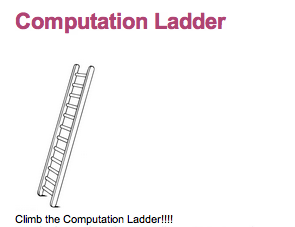- Identify the overarching learning goals for the class--make sure the goals are challenging and provide "tension" between what students now know and aim to know.
- Know where children are with respect to the learning goals.
- Be explicit about the learning goal, rationale and what that goal looks like (success criteria).
- Guide children's use of multiple strategies to both practice and learn as they approach the goal.
- Coach all along the way by providing feedback related to the task (don't combine praise and feedback).
- Listen to students' self-regulation and foster students' peer and self feedback through the use of prompts and guided reflection.
Why Feedback?
"Feedback serves various purposes. . .:it can provide cues that capture a person's attention and helps him or her to focus on succeeding with the task; it can provide information about ideas that have been misunderstood; and it can be motivational so that students invest more effort or skill in the task."
"Feedback thrives on errors."
"Error is the difference between what we know and can do, and what we aim to know and do--and this applies to all (struggling and talented; students and teachers). Knowing this error is fundamental to moving towards success. This is the purpose of feedback." The classroom climate needs to be one that embraces error as part of learning, a natural, welcomed process.
Feedback Leads to Learning Success
"In brief, the average effect size is .79, which is twice the average effect of all other schooling effects. This places feedback in the top ten influences on achievement."
Learning Depends on Challenging Tasks
If there is no challenge, the feedback is probably of little or any value: if students already know the material or find it too easy, then seeking or providing feedback will have little effect.
Effective Feedback Links Unknowing to Knowing
Feedback that Disconfirms Can Have Greater Impact than Feedback that Confirms.
Regular Feedback
Classrooms need to be marked by regular, effective feedback that clarifies intentions and criteria for success, moves learners forward, engineers effective discussion that provide evidence of learning, activates students as instructional resources for one another, and activates students as the owners of their own learning.
"For feedback to be received and have a positive effect, we need transparent and challenging goals (learning intentions), an understanding of current status relative to these goals (knowledge of prior achievement), transparent and understood criteria of success, and commitment and skills by both teachers and students in investing and implementing strategies and understandings relative to these goals and success criteria."
"Feedback needs to be focused, specific and clear."
Workshop in my classroom is one endeavor that lends itself to effective feedback and student learning. This is how I carry out this type of learning:
1. Together students and I establish the overall learning goal and purpose (w/prior knowledge in mind).
2. Together students and I create a to-do list that usually looks like this:
- Complete #1--see teacher if you have questions. (tasks are differentiated, review problem, fairly easy to complete)
- Complete #2--check in w/teacher (grade level plus review problems--teacher reviews, directs next steps.)
- Follow next steps decided after teacher check-in. (opportunities for greater practice, revised goal, success criteria--the learning progression tasks often assigned w/peers)
3. Students ask clarifying questions, list is adjusted.
4. Students go about completing the tasks, check in when ready. Teacher responds with feedback about next steps, corrections, new strategies, practice and more.
5. Student/teacher evaluation of outcomes, analysis and decisions about next steps for class, individuals.
Last year parents in my class wanted more feedback. I realize now that I was giving plenty of feedback, but it wasn't as explicit as it needed to be so that parents and students understood their role with regard to reaching the academic goals set. I will work on that this year.
As I continue to read Hattie's book, I find myself rethinking the way I facilitate lessons to activate and evaluate student learning--I am excited to put students center stage in classroom endeavor and I look forward to their enthusiasm and sense of ownership when they arrive at school and realize that yes, they are indeed in charge of their learning and they've got a paid consultant/coach to help them out--ME!
You have read this article with the title July 2012. You can bookmark this page URL http://the-bookself.blogspot.com/2012/07/educoach-chat-chapter-7-feedback.html. Thanks!



















